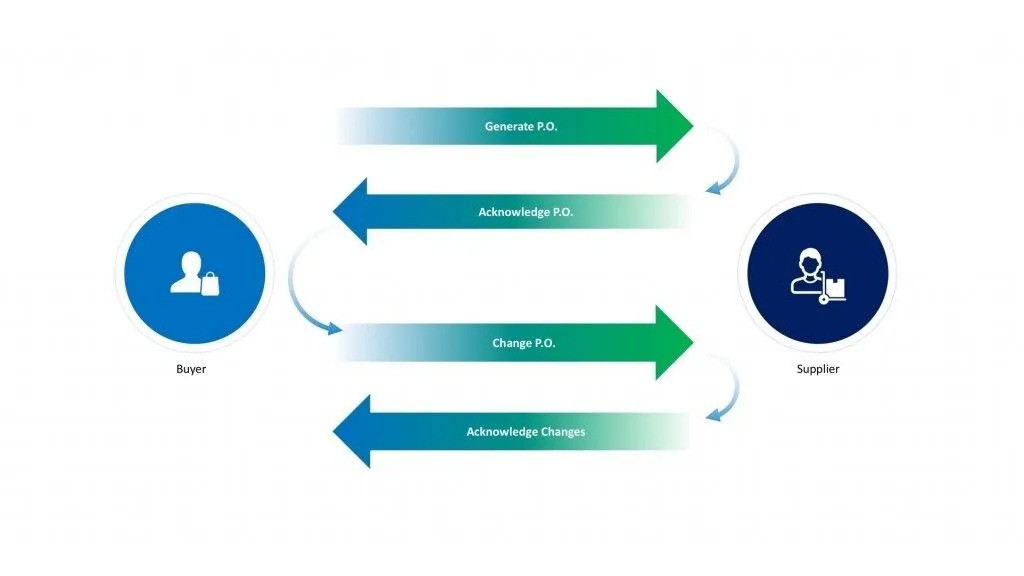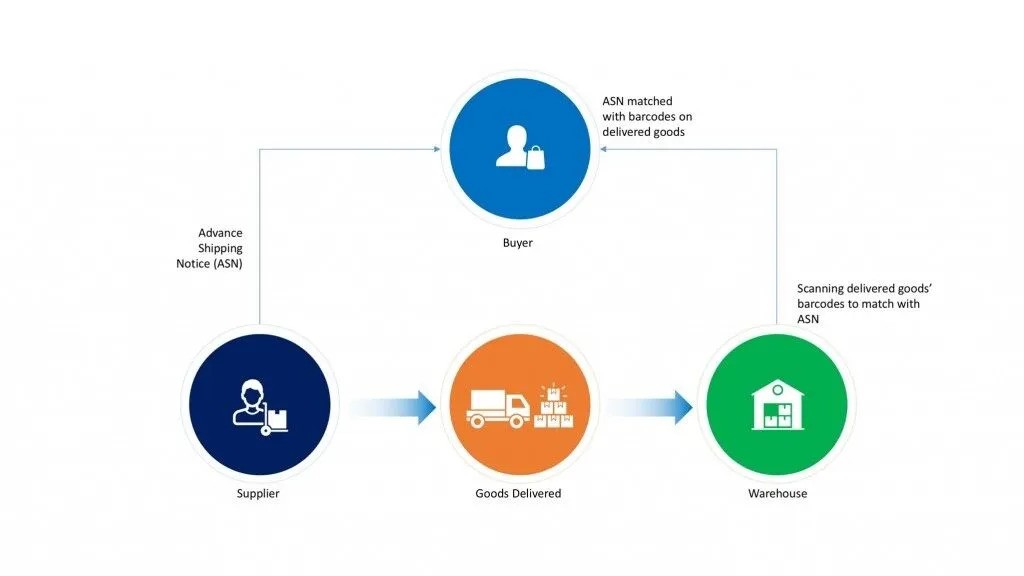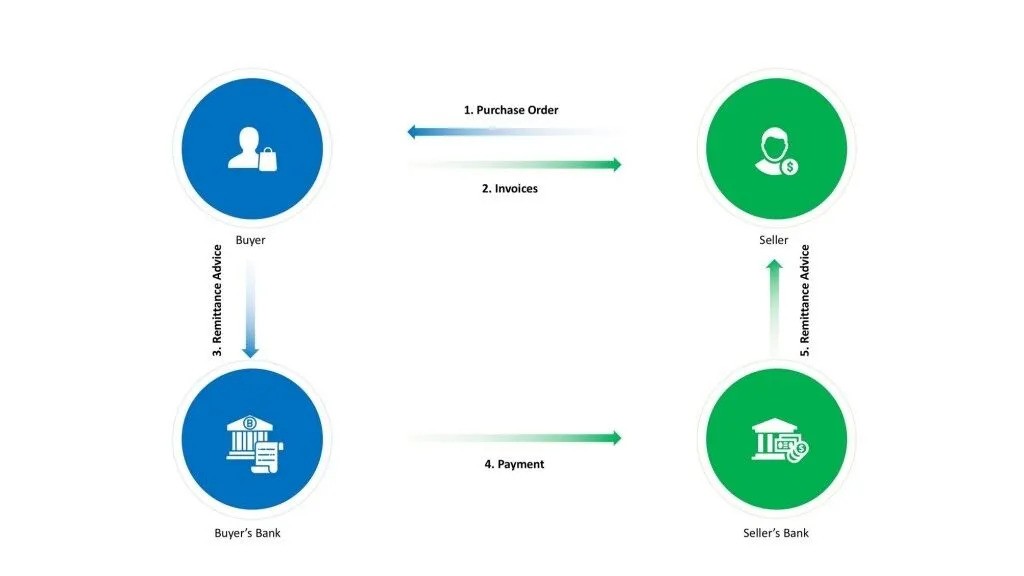NRF 2025 Retail Big Show
Join us at NRF 2025 Retail Big Show and explore how we're redefining retail connectivity and supply chain collaboration.
 PartnerlinQ
PartnerlinQ
Join us at NRF 2025 Retail Big Show and explore how we're redefining retail connectivity and supply chain collaboration.

We all agree to the fact that in today’s fast-paced, interconnected business environment, seamless data exchange is critical to staying competitive. For organizations who handle vast amounts of transactions, Electronic Data Interchange (EDI) has been an important method for automating communications between business partners. It is instrumental in reducing errors, accelerating transaction time, and eliminating manual processes. This, in turn, makes it indispensable for industries.
Having said that, not all EDI solutions are created equal. EDI Value-Added Networks (VANs) play an important role in ensuring that these electronic documents are securely transmitted between businesses.
In this blog, we’ll look at the leading EDI VAN providers, with a special focus on why PartnerLinQ has emerged as a market leader in EDI services.
Even before we dive into why PartnerLinQ is a market leader, it’s essential to understand what EDI VAN providers do. It is a centralized hub that allows organizations to exchange EDI documents with multiple trading partners. Services such as document routing, data validation, and compliance monitoring are offered by VAN providers. In this way, it makes sure that the business-critical data flows smoothly, and accurately across different organizations.
Some of the leading EDI VAN providers in the market include:
IBM Sterling B2B Collaboration: IBM Sterling has been a top choice for large enterprises needing EDI solutions as it is known for its security and compliance.
OpenText Trading Grid: OpenText is a cloud-based B2B integration platform that provides global trading partner connectivity.
TrueCommerce: It offers a scalable solution for small-to-mid-sized businesses, with easy-to-use EDI tools.
Even though all the above players offer strong services, PartnerLinQ has emerged as a leading player by solving key challenges faced by business when managing EDI systems.
Here is why PartnerLinQ has emerged as one of the leaders when it comes to leading the EDI VAN market.
The biggest USP of PartnerLinQ is that it offers a cutting-edge platform that integrates traditional EDI with modern data exchange solutions. This feature of PartnerLinQ makes it the organization of choice for companies that need both legacy support and forward-looking capabilities.
PartnerLinQ, unlike other VAN providers, incorporates APIs and real-time data exchange, enabling businesses to meet the needs of modern supply chains.
PartnerLinQ ensures businesses can operate efficiently and remain agile, even in the face of shifting market demands.
Traditional EDI VANs rely on on-premises infrastructure. However, as PartnerLinQ is built on a cloud-native architecture, it not only reduces the need for costly hardware and complex maintenance, but it also makes it scalable. PartnerLinQ ensures that updates are rolled out continuously, without disrupting daily operations.
Lack of visibility into data flows is one of the biggest challenges that businesses face when using EDI. Even now, a lot of VAN solutions use outdated batch processing. It has a tendency of leaving businesses in the dark about transaction statuses.
With PartnerLinQ’s real-time visibility and tracking features, businesses can monitor document exchanges in real time. This, in turn, empowers decision-makers to respond proactively to issues, preventing delays.
EDI systems are often siloed. However, PartnerLinQ integrates EDI with other supply chain management tools, ensuring connectivity across the entire supply chain. With PartnerLinQ, businesses can connect with suppliers, distributors, and third-party logistics providers (3PLs) on a single platform.
In today’s business world, where changing market conditions and customer demands are important, PartnerLinQ stands out as a next-generation EDI VAN provider. With its cloud-native architecture, and analytics, PartnerLinQ provides businesses with a comprehensive solution.
If you're looking to enhance supply chain operations, PartnerLinQ is your EDI provider of choice.

Many businesses struggle to take their data management and exchange processes to the next level. They may be using an outdated Electronic Data Interchange (EDI) solution, or they may not be using EDI at all.
If your business needs better data management, you may want to consider finding an EDI service provider. Here is an introduction to EDI and 10 considerations when looking for EDI service providers in 2025.
In an increasingly digitized world, businesses must also change how they operate. Many companies are now turning to EDI to manage their workflows better.
The global EDI software market size is estimated to reach a whopping $4.04 billion by 2029, compared to $2.88 billion in 2024.
EDI is the electronic interchange of business information following a standard format. It’s generally used to streamline transactions between companies. This process was once done using paper documents that had to be mailed back and forth, however, EDI now enables businesses to exchange data electronically and quickly.
While EDI refers to the process of electronically exchanging business data in a pre-defined format between systems, non-EDI is the traditional way of exchanging information without any pre-defined format. This would include using paper documents or even emailing attachments back and forth. Non-EDI can be very time consuming and expensive due to mailing costs. Non-EDI formats can include: Fixed length flat files, Variable length flat files, Binary files, to name a few.
EDI can be powerful to the business supply chain, automating and speeding up processes that would traditionally be done manually or through ineffective processes. Various organizations, including retailers, manufacturers, and distributors, can use EDI software to automate processes and improve data accuracy. It can maximize efficiency, improve overall experience, minimize errors throughout the supply chain, and provide the following key benefits:
To ensure your business is ready for the new year, you’ll want an efficient and reliable EDI service provider. Here are a few considerations to keep in mind when selecting one:
A good place to start is to make sure the provider can integrate with all the software you’re using. Finding an EDI service provider that uses an Application Programming Interface (API) for integration is recommended to make it easier to connect with your existing systems.
Integrated solutions are important because they can automate processes and make it easier to manage data.
Your EDI provider should not be specific to any one industry. This is because your business might branch out into new markets and you don’t want to change providers. An agnostic provider will also be able to give you a more objective perspective on how best to use EDI in your business and cater to your unique needs.
There are three main deployment models for EDI: on-premise, cloud-based, and hybrid. On-premise means the EDI software is installed and managed on your company’s servers. Cloud-based solutions are hosted by the provider and accessed through the internet.
Hybrid deployments use a combination of both on-premise and cloud-based resources. The best option for you will depend on your company’s size and needs, budget, and IT infrastructure.
Time to implementation is important, as you don’t want your business to be disrupted for too long. A good provider can give you a timeline for implementation and stick to it. As EDI can be difficult to set up, it’s important to ensure your provider has a good track record with other clients.
You should ensure that the provider you choose has a good understanding of your industry and your company’s specific needs. This way, they can help you select the best EDI software for your business and ensure a smooth transition to using it.
For example, your provider should be familiar with HIPAA compliance if you’re in the healthcare industry. Or, if you’re in the retail industry, your provider should know about EDI for e-commerce.
You’ll also want to make sure that your provider has a good understanding of the technology you’re using. They should be able to support you and help you troubleshoot any issues you may have.
Additionally, they should be up-to-date on the latest EDI software and standards so that you can be confident your business is using the best possible solution.
EDI data is often sensitive, so it’s important to ensure that your provider has a secure platform. Also, 80% of all cyber breaches happen in the supply chain, and 72% of companies don’t have full visibility into their supply chains. The platform should comply with industry security standards like HIPAA and PCI DSS.
One of the most important things to consider when choosing an EDI service provider is whether or not their solution is user-friendly. After all, you don’t want your employees to waste time figuring out how to use the software.
A good EDI service provider will offer a solution that is easy to use and comes with training and support so your employees can be up and running quickly.
As your business grows, you’ll want an EDI solution that can scale with you. A good EDI provider will offer a scalable solution so that you can add on features and functionality as needed. This way, you won’t have to switch providers down the road when your business expands.
Finally, select an EDI service provider with a good reputation. You can check online reviews and talk to other businesses in your industry to see what they recommend. Additionally, you’ll want to ensure the provider offers good customer support if you have any problems using their software.
As you browse EDI service providers that can offer all of these things, you’ll want to keep PartnerLinQ in mind. We’re a leading provider of EDI solutions and have over 25 years of experience helping businesses with their data exchange needs. With PartnerLinQ, our digital platform for communication with EDI and non-EDI partners, you can take full control of your supply chain.
If you’re ready to take your business to the next level, request a demo today and learn more about PartnerLinQ and how it can help you transform your supply chain ecosystem.

Clearly one of the biggest challenges businesses have with successfully executing an EDI integration strategy is the onboarding of new trading partners. This challenge appears regardless of network or affiliation and whether the solution is an everything-to-everyone VAN or a simple service.
The fact is that most Electronic Data Interchange (EDI) solutions including those recommended by a partner, an ERP provider, or a marketplace are still onboarding trading partners the same way as they’ve been doing for years; and if nothing changes in the practice, then nothing changes in the process and the same issues persist.
Many initiate the painful and often disappointing cycle of partner onboarding with their legacy product driven by internal needs. EDI service providers, in many instances, possess multiple legacy products and a pressing need to market an updated product or service subscription. The initial internal conflict within the service organization makes these providers slow to respond to requests for new trading partner requests
Additionally, they are often less inclined to deviate from established procedures, hindering much-needed changes to their practices. It is worth noting that at this stage, the practice is inundated with new and inexperienced resources. This poses challenges in adapting to evolving demands and adopting innovative approaches within the dynamic landscape of EDI.
Moreover, change is one of those necessary ingredients for survival in an ever-changing world, which includes newer ways of doing things even with legacy products. Much like fashion, change never goes out of style, and without integrating change into legacy or even antiquated platforms or practices, businesses simply cannot respond to modern EDI integration requirements that are needed in the market today.
Much of this change starts with the ongoing challenge of partner onboarding. The complexity of onboarding new trading partners begins with the EDI solution and how that solution has enabled change from the point where the solution team first encounters that next trading partner. Then there is the issue that companies leveraging EDI with their business partners cause based on a reluctance to provide precise directions by way of EDI specification documentation or samples in a sort of public forum.
Maybe companies do not know what their trading partner profile looks like or how to demonstrate it or just maybe they have never gotten around to producing or updating their specification document. In any case, keeping important EDI information behind a firewall and away from public view until the point where the opportunity to connect has arrived is certainly counterintuitive to making business work. Whatever happened to giving a partner a heads up?
Here are two recent customer examples that demonstrate how businesses are making it harder than it should be; the first example is an internationally recognized mid-market meal-kit foodservice provider and the second, two well-known fashion and apparel dynasties.
Let us begin with the first with one, an internationally known publicly traded mid-sized foodservice provider. In this example the food service provider’s business partner contacted PartnerLinQ asking how they could connect with them via EDI. As experts in the space, we naturally understood both the transactions and the steps needed to enable the EDI connection, so we set out on the path outlined by our customer’s business partner, which according to their web site, was to contact their EDI solution provider via a posted email address. So, we did just that.
Four weeks and dozens of emails later PartnerLinQ escalated the latency to our request to the business partner’s sales team, requesting a personal contact to get the ball rolling. During this process we also had to wait for the specification and sample documents to be forwarded to us to confirm, since there were no postings or even publicly displayed documents of any sort, not even an email address. Due to this oversight both our customer, the foodservice provider, and their business partner would not gain any benefit from using EDI for yet another month, further delaying any ROI that could be derived.
The second example is a well-known German shoe manufacturer, who produces and sells a particular brand of sandals and custom casual shoes known the world over. The problem arose when their business partner, a global footwear company that is home to a diverse portfolio of loved and admired brands and ferocious about fit, encountered an unexpected EDI connection issue more than a year after they switched their EDI systems to a new provider.
The business partner’s new EDI solution provider in this case was reluctant to fix the problem, even to the point of near refusal in remediating the connection issue. The reason provided was that the remedy fell outside of the classic remediation process. This same EDI solution provider doubled down on their refusal to fix the problem even after when one of the parties introduced options into conversation in an attempt to resolve the issue.
While these examples do not necessarily represent how everyone approaches EDI onboarding, best practice stipulates that your team is always responsive to email even when text is not received as intended.
After all, a global understanding of a ‘global standard’ is rather uncommon knowledge and EDI specifications no matter how precise they come are not proprietary. Many of the largest retailers and suppliers understand both, and make it their business to get connected, and in terms of specifications, make this information public.
The second part of these stories and the reason for writing this blog post is to help you get over, under and around such obstacles. Keeping your eye on the goal is critical and recognizing obstacles so they can be avoided in the future comes in a close second.
As you look into your EDI strategy for 2024, below is a list of those obstacles and what you can do to avoid them.
These war stories represent just a glimpse into the myriad experiences we have encountered in our journey, each contributing to our ability to diagnose problems effectively and apply best practices. At PartnerLinQ, we are dedicated to simplifying complexities.
We have been studying our EDI customers and competitors and recognize that digital agility between business partners is what most Multi Enterprise Collaboration Network customers want. Removing friction caused by multiple formats and connections is where we began. Beyond EDI, we’ve added an AS2 solution, an API Layer for Commerce Channel connections and included the ability to connect with a broad ecosystem of Commerce Platforms, Marketplaces, B2B Portals, Social Channels, Credit Cards, and Shipping Solutions
We are committed to making it easy and if you would like to explore your options with a PartnerLinQ Expert, we are happy to help and there is no obligation. Contact us today!

The holiday season is a time of opportunity and immense pressure, especially for businesses. With sales increasing by at least 30%, impatient consumers expect minimal wait time, partners look at filling immediate service requests, and burdened transportation and logistics cause delays. To top it all off, the employees need a vacation too!
The stakes are immense, with supply chains under stress due to surging demand, material shortages, and global disruptions. From warehouse operations to supply chain system management, skills gaps are affecting efficiency, causing delays, and ultimately impacting the bottom line. A recent survey by MHI revealed that 57% of supply chain executives cite hiring and retaining qualified workers as their biggest challenge—even surpassing material shortages and disruptions.
While technology can fill some of these gaps, it cannot do so alone. Combining innovative solutions and proactive workforce development is essential to alleviating holiday supply chain stress. That’s where PartnerLinQ comes in—a platform designed to transform your supply chain by integrating technology with your team’s capabilities.

PartnerLinQ streamlines supply chain operations, helping businesses like yours tackle holiday season challenges with ease. By simplifying the partner onboarding process through its Common Processing Workflow and exclusive "white glove" onboarding service, PartnerLinQ ensures rapid integration at the speed of business. With its intuitive Business Rule Manager, the platform facilitated the migration of over 1,000 partners and customers in just 12 weeks, demonstrating its swift and efficient integration capability.
Built on a scalable Azure-based hybrid cloud architecture, PartnerLinQ handles transaction volumes that ensure clients like a leading American transport and logistics company can process nearly 800,000 daily transactions—double their current requirements. This scalability empowers the company’s expanding carrier network without compromising performance.
PartnerLinQ simplifies IT infrastructure by seamlessly integrating with legacy systems and new TMS platforms. It eliminates extra licensing and enables greater operational efficiency through real-time updates and actionable insights.
Enhanced visibility enables clients to deliver consistent customer value at every touchpoint. Armed with service-level improvements, accelerated onboarding, and a better customer experience, our clients confidently continue to meet their service-level commitments, ensuring a smooth and stress-free holiday supply chain operation.
The holiday season doesn’t have to be synonymous with supply chain headaches. PartnerLinQ offers a comprehensive solution to navigate labor shortages, demand spikes, and operational bottlenecks by combining advanced automation with workforce enablement.
As the MHI report highlights, 74% of supply chain executives are increasing technology investments, and PartnerLinQ ensures that every dollar spent delivers measurable ROI.
Have I got your attention yet? If not, see how we do it.

Businesses turn to EDI solutions because EDI has proven to improve business efficiency and reduce costs. Compared to manual business processes, EDI helps reduce costs and inefficiencies up to 35%.
Businesses from Amazon to Zappos use EDI to take advantage of these benefits. In 2018, annual EDI transactions numbered over 20 billion. Combining EDI solutions with real-time APIs enhances partner communication even further, particularly for omnichannel operations with a large number of daily transactions.
In this blog post, we’ll talk about how implementing an EDI solution can streamline your business operations.
EDI was initially used in the procurement process to simplify paperwork. The procurement process involves four major documentation stages: purchase order generation, purchase order acknowledgement, making changes in the purchase order, and acknowledging those changes.
Traditionally, these processes were done by posting mail (or sending an email) to the recipient manually. Using EDI, these processes are automated. Retailers can send their suppliers an electronic purchase order and their suppliers can then respond with a confirmation record within seconds. Changes in purchase orders can be made and confirmed quickly, easily, and often without human intervention. Buyers and sellers alike can expect several immediate improvements with the right EDI strategy:
EDI vastly improves supply chain operations. Supply chain processes typically include an advance ship notice (ASN). Also known as an 856 or Ship Notice/Manifest, the structure of the message enables the transfer of information from seller to buyer at the shipment, order, pallet, pack, and item levels, providing the receiver information necessary to schedule shipment receipt and storage.

The ASN also accommodates common data elements used for business, including global trade item number (GTIN, i.e. the numerical representation of the barcode) and traceability elements like serial number, batch and lot numbers, expiration, packaging, and production. Relating harvest and use-by dates with these data elements at the shipment, order, pallet, pack, and item levels can help ensure consumer safety and reduce counterfeit goods.
EDI documents like the Transportation Carrier Shipment Status Message (214) and the Motor Carrier Package Status Message (240) from package delivery companies, couriers, logistics companies, and carriers enhance trading partners’ ability to track goods.
EDI is there when shipments arrive at the warehouse or on the consumer’s doorstep. The barcodes on the cartons can be scanned and data delivered by way of the ASN can be used to automatically update inventories, send confirmations and invoices, and if the shipments are somehow delayed, relevant personnel can be alerted immediately to address any concerns.
Automating the exchange of data through an EDI solution across the supply chain improves:
Read more: Improving your supply chain efficiency with ERP-integrated EDI
Businesses are always looking to improve business efficiency and reduce costs. Many are also concerned about the environment. Within the United States, some federal agencies have made e-invoices compulsory to reduce paper usage. Many countries have taken environmental and other concerns even further with countries including Spain, Brazil, Italy, and Mexico mandating the use of electronic invoices.

EDI solutions have a long record of success in improving communication and reducing fraud. Companies employing EDI solutions have also been able to save costs in paper, processing, postage, and invoice storage, furthering their operational goals of improving efficiency and reducing costs. Real-time access to electronic invoices and other business documents helps trading partners eliminate manual tasks commonly associated with paper-based process while improving days sales outstanding (DSO) and reducing payment penalties.
A properly designed, implemented, and integrated EDI solution offers businesses many significant advantages:
EDI-enabled companies are better prepared to focus on their customers without increasing overhead or administrative tasks. To learn more about how your business can migrate from a labor-intensive, paper-based business process to a modern EDI solution for your business, contact PartnerLinQ.

Visibility helps to transforms the supply chain from a series of isolated steps into connected, transparent processes that help organizations respond quickly to operational challenges and market opportunities.
At a time when supply chains are global and markets are volatile, being able to see and respond to change isn’t just a competitive advantage; it’s a must-have for survival and growth. Trend-spotters are winning the supply chain management game with next generation cloud-based supply chain solutions, while companies throttled by disconnected legacy systems and analytics applications are falling behind quickly.
Without real-time data on inventory levels and supplier capabilities, for example, identifying potential gaps, adjusting sourcing strategies, and tweaking production plans is nothing more than a guessing game. And as we all witnessed during the pandemic, that guessing game can turn into a liability quickly when outside forces take over the supply chain.
Rewind the clock a bit and its clear why supply chains fell prey to the pandemic-driven disruptions. Most business models relied on local production until globalization took hold and organizations started thinking and acting “leaner” when it came to inventory. Concurrently, the patchwork of legacy software systems that most companies relied on became increasingly disconnected and disparate.
When the pandemic turned supply chains on end, companies scrambled to reshore and gain better control over these vital networks. It wasn’t enough to just be lean; organizations also had to be resilient. The pendulum swung in the opposite direction as inventories were fattened up and more attention was paid to being able to fulfill orders (versus just keeping inventory costs minimized).
And so, the race was on to improve end-to-end supply chain visibility. However, for most organizations that end goal was out of reach. One of the root problems? Legacy systems that were put in place to support lean supply chains but lacked the flexibility to offer insights for changing demands and requirements due to increased complexity and shifts in global supply chains. These solutions are now ripe for modernization in a world where customers not only expect their orders fast, but they also want to track those orders every step of the way.
PartnerLinQ not only helps companies solve these fundamental problems, but we also help them achieve the visibility goals that were previously out of reach. It starts with a unified data repository that is harmonized for the specific enterprise, and that connects all the systems the company has in place — including those aging, legacy systems that would otherwise create drag in a business environment that demands agile and flexible supply chains.
Companies also need to know that their data is secure, safe, and kept confidential. They don’t want their data residing in a “public” system that’s shared with others. With PartnerLinQ, companies know that their data resides on a private platform and that it’s never treated as public data. This is an important consideration in a world where new cybersecurity threats emerge daily.
Because PartnerLinQ is elastic and cloud-native, the infrastructure behind it is both resilient and reliable. It can scale to any level in performance and manage all types of data. That data is both connected and harmonized in a way that ensures near-real-time visibility for business users who need analytics, reports, and dashboards that support good decision-making.
We recently worked with a large transportation company that has about 20,000 trucks along with data scattered across numerous data lakes and stores. Getting reports and analytics for efficient decision-making was nearly impossible — and by the time data was made available, it was too late to do anything meaningful with it. After implementing PartnerLinQ’s platform, the company was able to consolidate and harmonize these data sources with a robust canonical data model. As a result, PartnerLinQ improved the company’s access to critical information for making better decisions with improved reporting and dashboards to enhance its overall supply chain visibility.
This is just one example of how PartnerLinQ’s cloud-based platform helps organizations improve the visibility and efficiency of their supply chains. All these improvements translate into top-line cost savings, better asset utilization, and improved bottom lines. By acting as a conduit between different systems and partners in the supply chain, PartnerLinQ creates a seamless information flow and a clear, reliable snapshot of activity that fosters faster reaction times across these vital networks.

Jawad Khan is the founder and CEO of PartnerLinQ. As the innovative force behind PartnerLinQ, Jawad guides the company in reshaping digital connectivity and collaborative intelligence within the extensive supply chain sector. His leadership philosophy is deeply rooted in ensuring that supply chains are not merely reactive but strategically positioned to respond to perpetual shifts in business demands swiftly and efficiently.

Highly configurable technology platforms help companies achieve their visibility goals, collaborate with business partners, and eliminate manual work.
Most legacy supply chain management platforms currently in place were installed decades ago. These monolithic systems served their purpose, but they haven’t kept up with the demands of the modern supply chain. They’re not configurable, they can’t integrate with third-party applications, and they require a lot of manual intervention.
The challenges of using legacy systems don’t end there. Updating these platforms with the latest “bells and whistles” is expensive and, in many cases, not even possible. These solutions were built to do everything, which unfortunately means they don’t do any one thing very well.
As the name suggests, Enterprise Resource Planning (ERP) systems may be good financial and operational management tools across a compant, but they weren’t designed to manage the increased complexities of modern global supply chains. That didn’t stop ERP platform solution providers from adding a range of capabilities or otherwise acquiring other solution sets — from transportation management systems (TMS) to warehouse management systems (WMS) to order management systems (OMS) — to their software suites.
Customers, wanting all-in-one systems, often adopted those functionalities as they were introduced, never evaluating, or considering other options by assuming simplicity with one platform. However, this approach too often results in rigid IT infrastructures for which changing one requirement requires adjusting everything else, too.
While cloud ERP systems in the last couple of years have increased, on-premises solutions are still dominant within many organizations. On-premise legacy systems also weren’t designed for external collaboration — something every company needs but not all have. Where a TMS may have been built to connect with external carriers and transportation providers, on-premise WMS was designed to manage what was happening within the four walls of the warehouse.
The notion of external business partners being able to “see” one another’s inventory positions, and then use the data to help get customer orders delivered within two or three days, wasn’t available when most ERPs were being developed. This is just one visibility gap companies today deal with daily.
The good news is that organizations can close these gaps and future-proof their supply chains with a highly configurable technology platform. PartnerLinQ helps companies establish a common data foundation incorporating a semantic layer for every industry (including specific products, hierarchies, and transportation routes).
Once that foundation is established, we build out the platform with the customer’s unique needs in mind, using the technology already in place and the outside applications needed to get everyone working from the same playbook. By providing that critical connectivity layer, PartnerLinQ helps companies break through the barriers of their monolithic business systems and leverage the power of modern, advanced technology.
Connectivity barriers don’t exist only within your four walls. For that reason, PartnerLinQ creates strong connections with all third parties you need to communicate and share data with, including your business partners, customers, and software applications. The ability to integrate with these entities is a critical step to gaining full end-to-end supply chain visibility and collaboration.
PartnerLinQ offers the architecture, tools, and data companies need to connect with all internal and external stakeholders. We also offer a no-code/low-code environment that vastly speeds up implementation times and lets each person within the supply chain configure, maintain, and optimize the connections on their own.
As a cloud-native application, PartnerLinQ’s platform is vertically and horizontally scalable right out of the gate. The same can’t be said for many other supply chain integration platforms on the market today. With PartnerLinQ, you can scale from hundreds to millions of transactions per month without having to make changes to your system.
In this rapidly evolving business landscape, the right digital strategy is no longer a luxury — it’s a must-have. Organizations that fall behind in this area risk losing customers, market share and revenue to competitors investing in their digital strategies.
Being tied to a monolithic software platform can impede your supply chain visibility, partner collaboration, and long-term growth prospects. With PartnerLinQ in your corner, you can get all your data into one, accessible place. You can adjust on the fly as your company grows. And you can develop a future-proof supply chain that withstands the test of time.
To learn more about how PartnerLinQ can help you future-proof your B2B enterprise, contact our team today.

Ahmed Raza leads a dynamic team dedicated to shaping a robust, next-generation SaaS platform catering to customers across diverse industries. With his firm belief in driving continuous innovation, Ahmed’s team is on a mission team to ensure that PartnerLinQ platform remains at the forefront of business technology evolution. With a wealth of experience, Ahmed previously served as the Vice President of Product Engineering at Visionet Systems, Inc. His journey with the PartnerLinQ began at its inception, and over his 18-year career, Ahmed has played a pivotal role in a wide array of digital transformation projects spanning various segments of the supply chain industry. This includes impactful contributions to sectors such as retail, consumer goods, apparel/footwear, transportation, and food & beverage, among others.
Time is money in the fast-paced business-to-business (B2B) world. Each day a new B2B business partner isn’t onboarded and transacting with your company means one more day of lost sales and opportunities.
Clunky, manual onboarding processes also keep new partners from tapping into the amazing new alliance they’ve formed. Instead, they watch from the sidelines as you jump through your onboarding hoops.
“Fast partner connectivity is a predominant factor for growth in the B2B business landscape,” says Kerry Fogarty, SVP of Client Success at PartnerLinQ. “The faster you can get new partners up and running, the sooner you’ll be able to maximize the return on your partnership investment.”
Complex, manual partner onboarding processes consume too many internal resources. They also delay time-to-market and force new B2B partners to “stand by” while you get your house in order. A smooth onboarding process, on the other hand, reduces administrative burden and lays the foundation for a strong, lasting partnership.
By investing in tools that automate everything from data migration and training to user provisioning — all wrapped in a white glove service package — organizations can create a frictionless onboarding experience that benefits all parties.
Consider these wins, achievable across the life of the partnership:
Because PartnerLinQ integrates directly with over 70 popular software applications like Microsoft, Dynamics, SAP, Salesforce, and Magento, all data can flow seamlessly across these platforms, giving companies a single, unified pool of data to work with.
PartnerLinQ’s tailored service approach takes it one step further by managing communications across trading partners. “We provide a dedicated onboarding service agent who takes the burden off our customers’ in-house staff,” Fogarty explains. “By managing this on their behalf, we can target 100% of their training partners.”
For a company that is replacing a legacy integration platform, PartnerLinQ manages the communication, scheduling, configuration, testing, and deployment for all existing and new trading partners.
“We act on our customers’ behalf, letting their partners know about the platform switch and managing all of the related intricacies that go into it,” Fogarty says. “The day we go live, we throw switches and everything is up and running on our platform across the board. This significantly compresses the time-to-value.”
Streamlining integrations can have a significant impact on a company’s bottom line. Take this example: A transportation company spent about five years attempting to migrate 20% of its customer base to a new platform. What’s more, onboarding each new partner took more than 100 days apiece.
By switching to PartnerLinQ, the company was able to speed up the integration considerably. It began onboarding anywhere from 50 to 100 trading partners twice a week in a multi-week cycle. The company can implement a new trading partner in five days or less. And it doubled the number of trading partners it works with because it’s no longer bogged down by manual, legacy processes. The company has gained significant market advantage and enjoys stronger business partnerships as a result.
“As more companies take advantage of these types of seamless integrations, they can respond much more swiftly to market changes and shifting customer demands,” Fogarty says. “They can also keep up with and even get out in front of their competitors.”
A fast, seamless B2B partner onboarding experience helps organizations unlock the full potential of their partnerships right from the start. Isn’t it time you replaced your outdated onboarding methods with a frictionless journey that sets everyone up for success?
To learn more about how PartnerLinQ can improve partner onboarding, reach out to our team today.

Kerry Fogarty is a Senior IT executive with a proven track record in driving global IT initiatives and business value impact through technology adoption. With his extensive experience as a VP of Enterprise IT and the Office of the CIO in iconic brands like Liz Claiborne, Fifth and Pacific, Kate Spade, and Tapestry. Kerry brings a wealth of deep industry supply chain knowledge and expertise to the PartnerLinQ, Inc., leadership team. In his current role as SVP Client Success, he is dedicated to ensuring customer success through the deployment of PartnerLinQ, the industry’s premier supply-chain platform, complimenting it with toptier consulting and support services.
PartnerLinQ helped a leading multinational sports footwear and apparel company modernize its B2B/B2C platform, making operations more efficient and expanding its markets into other countries. PartnerLinQ delivered a cloud-based solution with end-to-end visibility, control, and limitless flexibility, including native supply and demand chain integrations such as API and EDI-based transaction integration. The solution also allowed for retiring legacy solutions quickly and without affecting business operations.